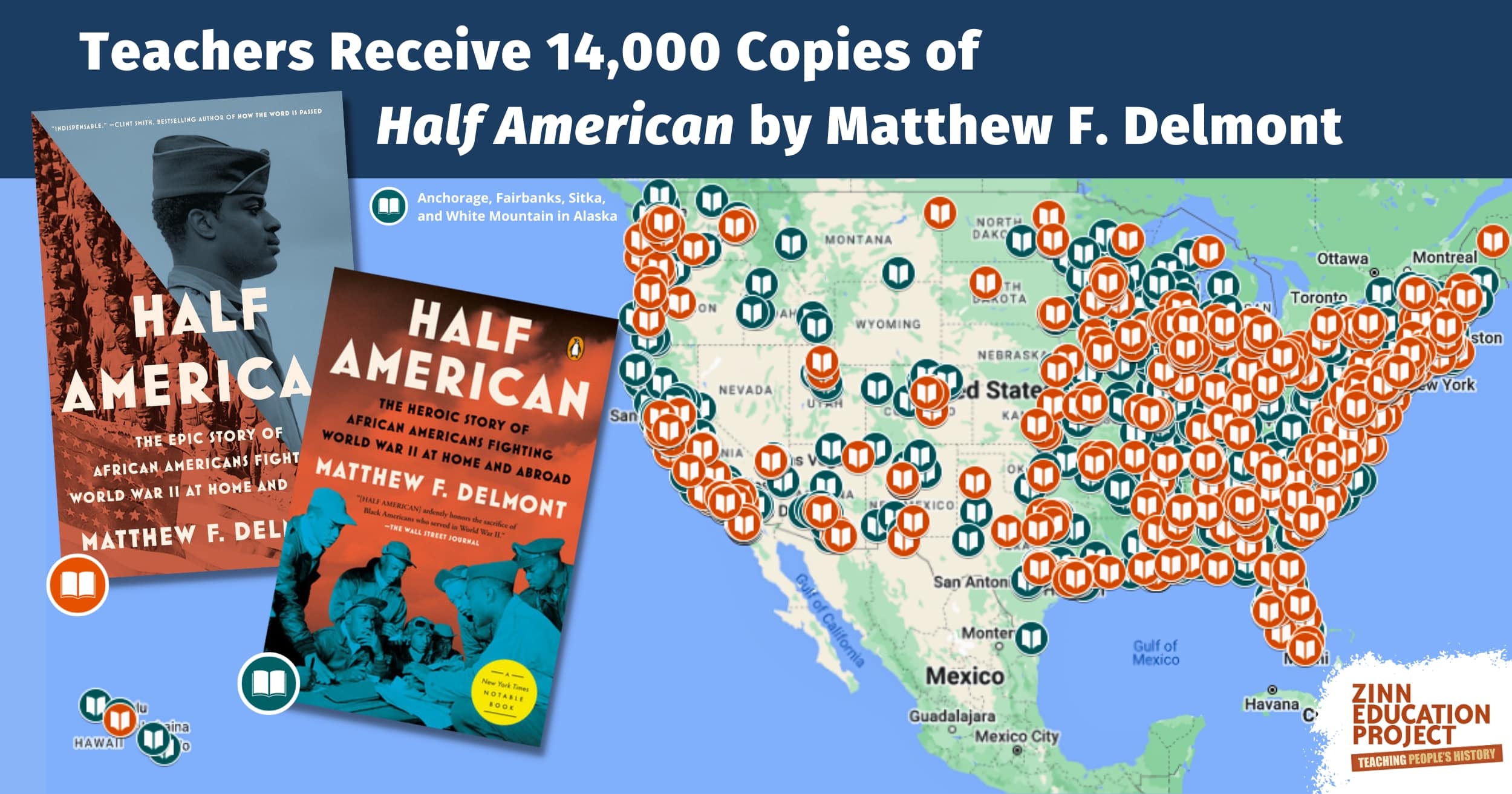
While right-wing legislatures restrict the teaching of Black history, we are pleased to support teachers who work to teach truthfully about U.S. history.
Thanks to a generous collaboration with Dartmouth College historian Matthew Delmont, the Zinn Education Project sent 14,000 copies of Delmont’s book Half American: The Epic Story of African Americans Fighting World War II at Home and Abroad to public school teachers, school librarians, and teacher educators. This included 4,000 hardback copies in 2022 and 2023 — and 10,000 copies of the 2024 paperback edition.
Half American chronicles the lives of African Americans who fought in World War II and in the war against racism in the United States. The book includes stories that can be woven into the curriculum of key people and events, such as: Thurgood Marshall, the chief lawyer for the NAACP, who investigated and publicized violence against Black troops and veterans; Ella Baker, the civil rights leader who advocated on the home front for Black soldiers, veterans, and their families; James Thompson, the 26-year-old whose letter to a newspaper laying bare the hypocrisy of fighting fascism abroad when racism still reigned at home set in motion the Double Victory campaign; and poet Langston Hughes, who worked as a war correspondent for the Black press.
In a class with teachers, Delmont explained the relevance of learning this history.
If we look back and think that World War II was a simpler time, or a more peaceful or unified time, it makes it seem like protests around racial justice today are surprising, or that they’ve come out of thin air. If you tell the actual history about what happened in World War II, it’s clear that these battles have been going on for generations. Part of the urgency of the Black Lives Matter movement in the last decade is that people’s grandparents were fighting these same battles in these same streets, going back to World War II and earlier.
Distribution of Delmont’s book is a direct challenge to the widespread removal of books from libraries and classrooms across the country.
In addition to the support of Delmont and Dartmouth College for the books and shipping, individual donors to the Zinn Education Project made possible the outreach, screening of requests, and follow-up story collection.
Teaching Stories
Teachers who received the hardback edition have shared their appreciation and teaching stories, including those below. We’ll add more once teachers use the new paperback edition.
High school history teacher Amanda Sandoval was one of hundreds of educators who received copies of Half American: The Epic Story of African Americans Fighting World War II at Home and Abroad from the author Matthew Delmont and the Zinn Education Project.
Delmont’s book asks readers to rethink what they know about the war by centering Black protagonists. He writes, “Nearly everything about the war — the start and end dates, geography, vital military roles, the home front, and international implications — looks different when viewed from the African American perspective.”
Sandoval had her students create blackout poems with the books’ introduction, making evident the power of the text.
Amanda Sandoval shared the slide instructions for the blackout poetry that she used for this activity.
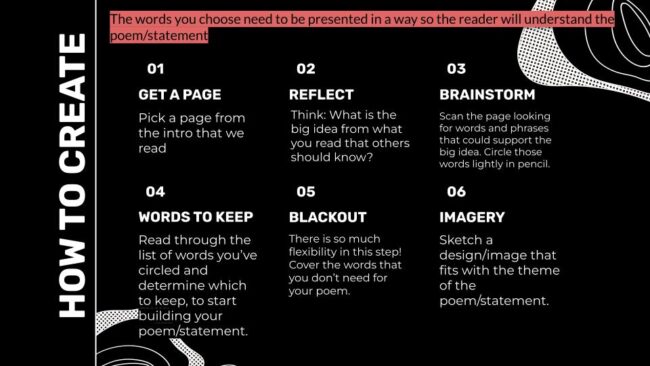
Reading the book Half American has changed my perspective on teaching about World War II. I had always heard the traditional narrative of how the home front came together to support the war effort, but the stories told in the book showed me the myriad ways this was not true for African Americans. While I was aware of segregation and racism in the military at this time, and the response to returning veterans like Isaac Woodard, I hadn’t realized all the ways African Americans were discriminated against, particularly with regards to the violence shown towards them and the efforts to keep them from fighting in Europe and the Pacific.
A huge “Thank you!” to the @ZinnEdProject for gifting us a class set of @mattdelmont’s newest book, _Half American: The Epic Story of African Americans Fighting WWII at Home and Abroad_. I will use it in my APUSH classes as well as my Ethnic Studies classes! pic.twitter.com/0ADtH573Jf
— Don Dumas (@don_dumas) December 5, 2022
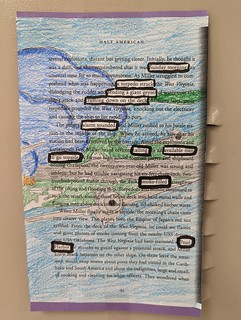

I received Matthew Delmont’s book, Half American: The Epic Story of African Americans Fighting World War II at Home and Abroad, from the Zinn Education Project. I really enjoyed the book and wanted to share it with my students.
At the beginning of our unit on the WWII, I talked to the students about how the war, like many events in American history, impacted people in different ways and our goal was to see the war with new eyes through specific groups of people who lived it.
We started by watching an interview with Matthew Delmont about the purpose of his book and how he hoped to shed light on the vital role African Americans had in the war effort and their hope of a Double Victory. Then, at the beginning of each class period for the entire unit, we spent 15 minutes reading from the text. It was a really positive way to start and frame each class period.
We finished the unit with a culminating project that was inspired by a fellow history teacher, Amanda Sandoval. Students created blackout poems, which highlighted a major theme from the book. Each student chose one page from the book that would be the base of their poem. On that page, they selected words or phrases that supported the overall theme. Students covered the rest of the book page with an image that connected back the main idea. The only words remaining visible were those that created a new statement or poem about the African American experience in WWII.
I currently have pictures of the students’ final products on display in the hallway of our school for the rest of the student body to see and read.
Read More Classroom Stories
We received copies of Matthew Delmont’s Half American: The Epic Story of African Americans Fighting World War II at Home and Abroad and are beginning our social studies department reading group around this book. It has been a great resource so far presenting perspectives that are often overlooked in the larger narrative about WWII. It has been influential in thinking about the resources we choose to put in front of students.
The introduction brought up an interesting point when discussing Saving Private Ryan. The opening scene of that movie is commonly used throughout history classes that discuss D-Day and World War II, but the intro brings up an interesting point and makes us reconsider the resources we use and who is centered and who is left out.
As we continue our discussions around this topic we will strengthen our content knowledge around the topic of World War II and more specifically United States and African American involvement in World War II. This book will be a valuable resource in our unit on World War II which is covered in 10th and 11th grade. It will also be helpful when thinking about the resources we choose for other topics to try and think about which stories we leave out.

Three years ago I joined a Teaching for Black Lives study group and have been using the Stories from the Climate Crisis: A Mixer lesson and Reconstructing the South: A Role Play ever since. The lessons are engaging and have my students consider perspectives that they would not usually be exposed to. I was even able to take the Climate Change Mixer and use it to create similar assignments for other subjects or lessons that the students liked. In my experience, the Zinn Education Project encourages students to think and problem solve based on their own ability to reason. These valuable skills can carry beyond the classroom and help make for responsible citizens out in the world.
Furthermore, students have enjoyed reading Sugar, Half American, and Paradise on Fire. These stories add visibility and diversity to the classroom — something that is often hard to come by and hard to afford as a public education teacher. Anything and everything that the Zinn Education Project shares with a classroom is a vital component of that class going forward.
Talking of perfect timing, this arrived today, and I am in the midst of teaching WWII. Thank you, @ZinnEdProject, for helping me teach my students. I have another book to add to my class collection of teaching about WWI and WWII. #TeachTruth #BHM2022 pic.twitter.com/LFDfO1qcQM
— Valencia Abbott (@vannabbott) November 8, 2022
In my U.S. History class I teach a lesson about the African American experience in WWII using primary sources. Students read the James Thompson editorial “Should I Sacrifice to Live Half American?” from the Pittsburg Courier and the Double V campaign. Students later consider Executive Order 9981, which desegregated the military, and write their own editorial like James Thompson about racial equality in America and in the military.
The book Half American has sparked many ideas to add depth and empathy to this lesson. Additionally, the book was fascinating and engaging to read, and I really appreciate the Zinn Education Project for providing this book to me for free to add to my personal and professional library.
This lesson always sparks very good conversation about what it means to be an American and the important and unique struggle for rights minority groups like Black Americans have led. This lesson gets students to see part of the story of the long Civil Rights Movement that began well before the sit-ins and bus boycotts.
In conjunction with this lesson, I also teach one about the Japanese-American experience in WWII that adds complexity to students’ understanding of rights and freedoms in wartime and how minorities face unique challenges and experiences. All told, this book has added so much to my ability to teach a richer and more complete U.S. stories.
@ZinnEdProject Thank you for an outstanding session and for the free copy of the book. It is enriching my practice as an educator and a citizen. pic.twitter.com/L9P4BHe3Ub
— JOYCE MCCREE (@msjmccree) November 29, 2022
I first attempted to do a book study the week before Thanksgiving (short week), but the students complained the book was too long; though they did like the subject matter. So, I decided to focus on chapters 7, 3, 5, and 12 during Black History Month. It produced some amazing discussions.
Many of the students, of all races, were angry that the military didn’t allow the Black soldiers to handle weapons, and felt they were “slaves to the White soldiers” by doing their laundry, shining their shoes. They also said our government was two-faced: Talking about soldiers working together against the common enemy but having segregated quarters for the Black and white soldiers.
Before giving them their written assignment, I showed them a clip from Pearl Harbor, where Cuba Gooding Jr., portraying Doris Miller, proceeds to use the gun to fight the Japanese pilots. They were angry that the government took four months to identify and give Miller a medal for being a hero, when white soldiers received recognition right away. I later showed them that the Navy christened a frigate in Miller’s name, an honor only given to former presidents.
Since we are a secured facility (juvenile detention), I printed research for the following people: Langston Hughes, Thurgood Marshall, Doris Miller, James G. Thompson, Benjamin O. Davis, Della Raney, Private Robert Brooks, Charles McGee, Wallace P. Reed, Ella Baker, W.E.B. Du Bois, and the “Black Rosies.” They wrote an essay about one of the people: List three (or more) facts about the person, explain how his/her character enabled him/her to rise above the adversity of their community, and justify how their actions made an impact on U.S. history. Once written, they then had to present the person they researched, and in their presentation, explain why their chosen person was a hero. Almost every student stated that the fact they stood to honor and protect a country that didn’t treat them right made them heroes.
Many of the students asked why they never heard of some of these people during WWII. Many were shocked that “Black Rosies” were doing the same things as Rosie the Riveter. I will definitely present this unit again.
A student asked if he could take the book to his room to read, but there’s a policy against having hard covered books on the living units. I went to a supervisor, showed her the book and explained what I was doing, and she was impressed. She took down the information, and she said she’d look into ordering soft covered copies to put on each unit.
|
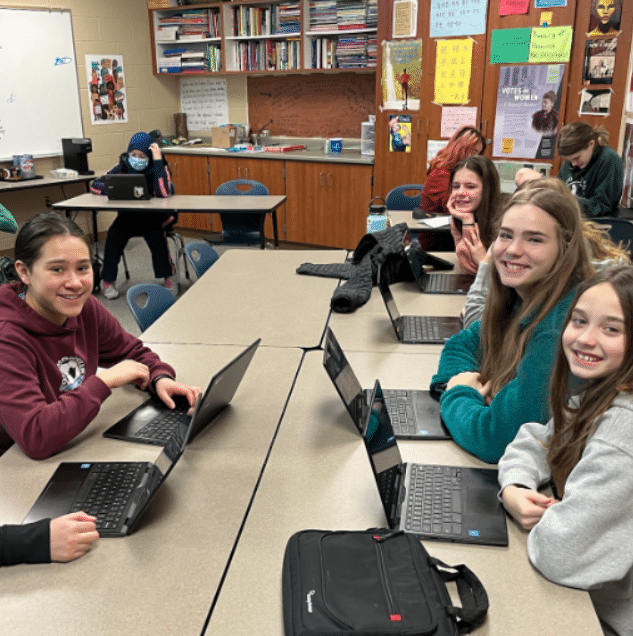
I received multiple copies of Matthew Delmont’s book Half American: The Epic Story of African Americans Fighting World War II at Home and Abroad. I teach a variety of classes, grades, and extracurriculars, so I knew I could incorporate this text in many ways.
One way I used this text was to have students read excerpts from Chapter 3, “The March on Washington,” as part of a unit about community organizing and advocating for the changes you believe are needed in your community. I paired it with the lesson on Zinn Education Project website around the various stakeholders in the DAPL debate, and a culminating assignment asking students brainstorm, write, gather support, edit, and send proposals to their school board regarding improvements they wanted to see in their own education.
In particular, a quote from pg. 62 of Delmont’s book was useful, and I returned to it many times:
For Randolph and millions of other Black Americans, the lesson from the March on Washington Movement was that ordinary Black citizens possessed a tremendous amount of political potential. The key was to harness it to fight for specific goals. “You possess power, great power,” Randolph said. “In this period of power politics, nothing counts but pressure, more pressure, and still more pressure.”
Thanks for sending these texts to me. I appreciate it!
Half American by Matthew F. Delmont has completely changed the way I teach World War II and the Civil Rights Movement in my 12th grade government class. Typical textbook curriculum teaches the Civil Right Movement as an isolated event; however, Delmont’s book taught me that the movement’s roots are with injustices and hypocrisies during World War II. Students are shocked to read the quotes from articles written by the African American newspapers that show a completely different perspective of the war (abroad and domestically) than that described in textbooks.
After reading this book, I will always teach the WWII Double V campaign in order to include these voices. A part of the book that particularly affected me was the treatment of Black troops on U.S. military bases. I was stunned by the soldier’s letter to the NAACP from Pearl Harbor prior to the attack about the treatment of Black sailors by the Navy. Again, it’s an example of how a textbook completely leaves out voices that are vital in understanding events.

I recently used Matthew Delmont’s book Half American to challenge students’ perceptions about World War II. Students read the introduction and completed blackout poems. Afterwards, small groups of students were assigned a specific chapter of the book to read, discover claims made, and see how the author used evidence to support these claims.
Students were tasked with a creative way to demonstrate their learning and could choose between the following: Creating an African-American “heroes” gallery; creating a movie trailer for the chapter using WeVideo or another platform; creating an infographic to demonstrate learning by numbers; creating a digital collage; or curating a collection of additional primary and secondary sources based on original research, or a student generated idea. I was very pleased with the student engagement and the creativity used to demonstrate learning.
Delmont’s book is an incredible resource for the classroom that challenges students’ perspectives about World War II. Delmont recenters African Americans in the narrative of the war to show what it really meant for African Americans from a variety of walks of life. I highly recommend teachers consider this exquisite resource. My students encountered people and ideas that they had never heard of, and leveraged technology and creativity to produce resources that not only demonstrate but advance learning.
Our school district has banned books on the Black experience. So, we did a Zoom session with veterans and their grandchildren, nieces and nephews, and shared from the Half American’s specific parts that spoke to them or that they experienced in real life. We had conversations so that all could learn from the book and from actual life experiences of the adult to middle/high school participants.
Some of the high schoolers were considering going into the service and felt enlightened about the racism that persisted and the determination of the veterans in the story, as well as the determination of their relatives who shared that they too lived during this time period. It was a living history lesson on both levels, via the book and via accounts shared by veteran relatives.
The challenge going forward is to think of ways to persist under hardship or crisis and find ways to reinvent the self under these conditions with dignity and honor. The students were to make a dream board of a story chosen from the book, use them as a mentor for their future, and pick pictures and words or quotes that would continue to inspire them.
I ask my students to read a book about walking in someone else’s shoes. We discuss the issues of under-represented views and stories all year long in literature and social studies. Social studies culminates with a unit on major reformers throughout history and how they changed things.
Here is what two of my students said about Half American.
I thought it was very interesting that I had no idea about all this. I have learned about WWII several times, and have heard nothing about this. It was very interesting to read and I like the perspective. I think it is really important to learn about this.—Agatha
I thought it was interesting in the book Half American that it was Black Americans who identified the threat from fascism long before much of the rest of the nation did, and who were among the first to see the war as an existential struggle between forces of fascism against the forces of freedom, democracy, and human rights. —Makenzie
Although I was given a copy of Half American, I was not allowed to utilize it in my classroom. As a teacher who prides themselves on inclusive teaching, I was instructed at least three times this school year to ensure I am teaching about and praising white people in my class. My administrator is constantly worried about white students in my class, even though I am white myself. I am super thankful for the Zinn Education Project sending me a copy of this amazing book but in Oregon we are not permitted to truly teach about BIPOC people in our classes.
In my African American history class we read and had discussion responses to excerpts from chapters 14 and 17. These chapters really underscored the important role African Americans played in the War and the terrible betrayal they received when they returned. This activity was the culminating activity of our lesson on African Americans in the first half of the 20th century.
Learn More
Listen to an interview with historian Matt Delmont in conversation with ZEP team member Jesse Hagopian in our Teach the Black Freedom Struggle online class. Excerpt below and the full class here.

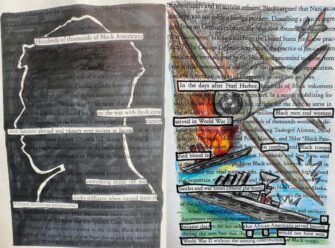







Twitter
Google plus
LinkedIn